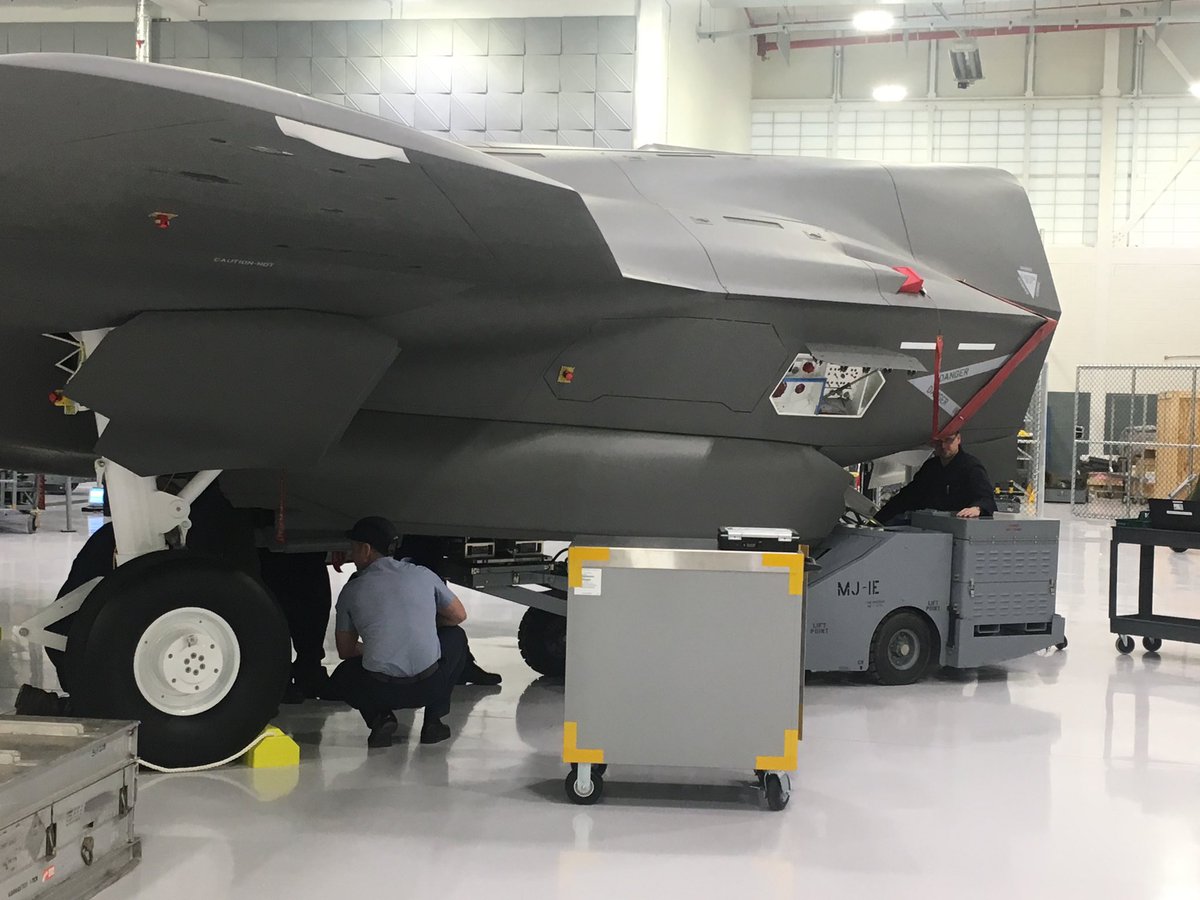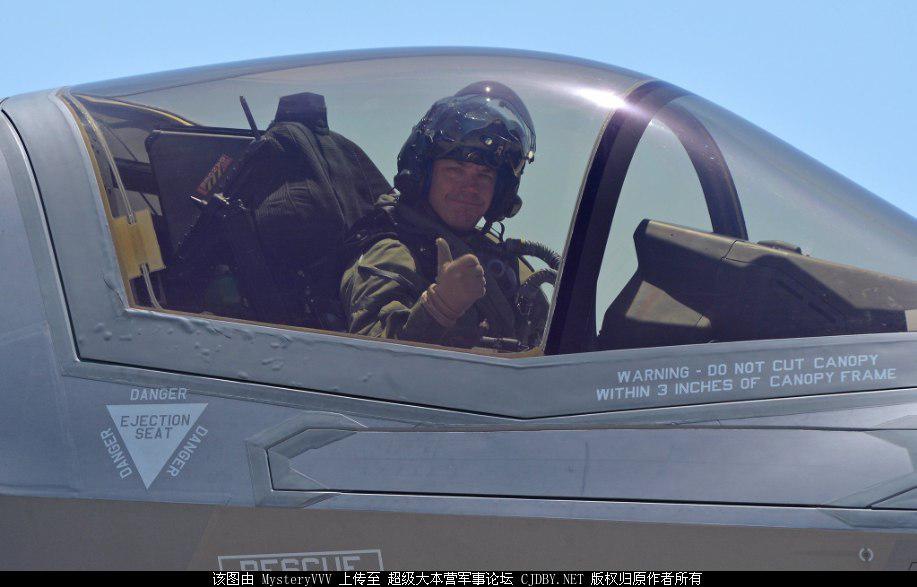You are using an out of date browser. It may not display this or other websites correctly.
You should upgrade or use an alternative browser.
You should upgrade or use an alternative browser.
F-35 Joint Strike Fighter News, Videos and pics Thread
- Thread starter Jeff Head
- Start date
Looks like some kind of "wrap" on the canopy frame, or else the coatings are raising due to humidity
Jura The idiot
General
located that picture atLooks like some kind of "wrap" on the canopy frame, or else the coatings are raising due to humidity
there's this close-up down in the page
:

I just check several dozen photos of F-35s and this is the only one I've seen with these sort of imperfections on the cockpit. Don't know what it is. Since I'm no engineer I don't know what effect this will have on the stealth ablity of the aircraft. Apparently this imperfection is not enough to ground the aircraft.
Jura The idiot
General
Sunday at 11:57 AM
whileDec 23, 2018
interestingly,
Acting Sec Def Blocked From KC-46 Delivery Decision, Involvement in All Boeing-Related Programs
1/3/2019
I just check several dozen photos of F-35s and this is the only one I've seen with these sort of imperfections on the cockpit. Don't know what it is. Since I'm no engineer I don't know what effect this will have on the stealth ablity of the aircraft. Apparently this imperfection is not enough to ground the aircraft.
That's the radar absorbent material, and it limited to the canopy frame, so its a really small area, one of the many benefits of the F-35 is that the coatings are relatively easy to patch and repair.....
If that's an F-35 Bravo, the harsh ocean environment aboard ship is salty and abrasive high humidity, its hard on everything..
The long and short of it, its a problem as it affects longevity, but is has nearly zero affect at that stage on L/O, but if it lifted and began to flake off, you would need to pull it into the shop and repair it, I know a lad in the marines that is an expert at coatings on the F-35 Bravo, that is his job!
Jura The idiot
General
related:
UK defense chief: F-35 jets are ‘ready for operations’
Britain has declared initial operating capability on its F-35B Lightning fighter fleet in an announcement made by Defence Secretary Gavin Williamson during a Jan. 10 visit to the aircraft’s new base.
Williamson also took the opportunity to confirm the successful culmination of a $540 million program to upgrade the Royal Air Force's Eurofighter Typhoon fleet with Storm Shadow cruise missiles, the Meteor air-to-air missile and the Brimstone ground-attack weapon.
“The incredible F-35 jets are ready for operations, a transformed Typhoon has the power to dominate the skies into the 2040s and we continue to look even further into an ambitious future,” the defense secretary said.
The British have nine of the short-take-off, vertical-landing version of the F-35 ready for overseas deployment, said Williamson. He was speaking inside a new maintenance hangar that is part of a $700 million investment the Defence Ministry is making at RAF Marham, the main base for the Lockheed Martin-built fleet of jets.
Sixteen F-35B aircraft have been delivered to the British and are currently based in the U.K. and the United States.
The government ordered a further 17 fighters late last year for delivery between 2020 and 2022.
The British have said they will buy 48 jets to meet immediate requirements for a joint RAF/Royal Navy force and have committed to buying a total of 138 aircraft, though officials have given only a vague time line.
The Royal Navy began flight trials of the aircraft from the deck of its new 65,000-ton aircraft carrier HMS Queen Elizabeth last year.
Work has been underway for some time in the ministry over whether part of the future orders for the Lightning II should include a batch of F-35A types for the RAF, with the F-35Bs being earmarked just for Royal Navy service.
A spokesman declined to comment on the timing of a decision.
“The first tranche of 48 aircraft will be the F-35B, which will be jointly operated by the Royal Air Force and Royal Navy and capable of operating from both land and the Queen Elizabeth-class aircraft carriers. Decisions on subsequent tranches of Lightning will be taken at the appropriate time,” he said.
Howard Wheeldon, a commentator on the defense-aviation sector here, said the possible mix of F-35 A and B variants was one of the items the government still needed to study to ensure a credible F-35 force.
“They need to set out a clear strategy, as opposed to mere definition of intent, in respect of required capacity in numbers and requirement for both the 'A' and 'B' variants. How many U.K.-owned 'B' variants do we really need for carrier strike, and will we see U.S. Marine Corps aircraft permanently based on U.K. carriers?” he said.
The U.S. Marines are expected to fly their own F-35B from the deck of the British carrier in early deployments, in part because the Royal Navy will have insufficient numbers of its own aircraft until numbers build up.
Williamson made the announcement about F-35 IOC in the hangar standing in front of four generations of current, and perhaps future, British fighter jets.
The Tornado, which is about to go out of service after 40 years of frontline action, the Eurofighter Typhoon, which provides the backbone of RAF combat capability for the foreseeable future, the F-35B and the Tempest, a plastic mock-up of a possible sixth-generation fighter unveiled during the Farnborough air show last year.
The business case put together to establish the Tempest program was delivered late last year, the Ministry of Defence has confirmed to Defense News.
The British government has set aside £2 billion, or roughly $2.6 billion, to begin development of Tempest, but a final go-ahead decision is not expected until 2025 for a fighter delivered sometime around 2035.
BAE Systems, Leonardo and Rolls-Royce are among the industrial participants in the project.
Some industry executives here think the cash-strapped British might cut F-35 numbers to fund Tempest.
That would also favor buying the cheaper-to-operate F-35A version for the RAF, they say.
Discussions are underway with potential partners like Sweden and Japan to join a program, which would be unaffordable for the British to shoulder alone. A tie-up with the rival German-French fighter program remains a possibility.
The initial operating capability for the F-35B and the success of the Typhoon weapons upgrade, known as Project Centurion, was a significant step towards the building of of Britain’s next-generation air force, according to Chief of the Air Staff Air Chief Marshal Sir Stephen Hillier.
“With its cutting-edge stealth technology, our F-35s are now ready to deploy on operations and, alongside our combat-proven Typhoon, offer a step-change in our ability to employ air power around the world, “ he said.
“Furthermore, the successful integration of Storm Shadow, Brimstone and Meteor on Typhoon completes and enhances the transition of world-class capabilities from Tornado and allows a stalwart of the RAF’s combat air inventory [Tornado] to retire from service,” said Hillier.
MBDA’s Meteor beyond-visual-range missile operationally launched with the RAF for the first time last month during a quick-reaction alert mission from RAF Lossiemouth, Scotland.
The F-35 is currently only armed with Paveway precision-guided bombs and ASRAM and AMRAAM air-to-air missiles, but the British have plans to upgrade its strike and defensive power.
“As part of the follow-on modernization program, the program will clear Meteor, SPEAR Cap 3 [medium-range, air-to-surface missile], Paveway 4 Mk3, Paveway 4 tactical penetrator and Block 6 ASRAAM” for use on the F-35, said an MoD spokesman.
Jura The idiot
General
why don't I repost some PR stuff LOL!
Ground crew of learning how to load bombs on at shiny new Marham facility

Ground crew of learning how to load bombs on at shiny new Marham facility


